Happy Holidays
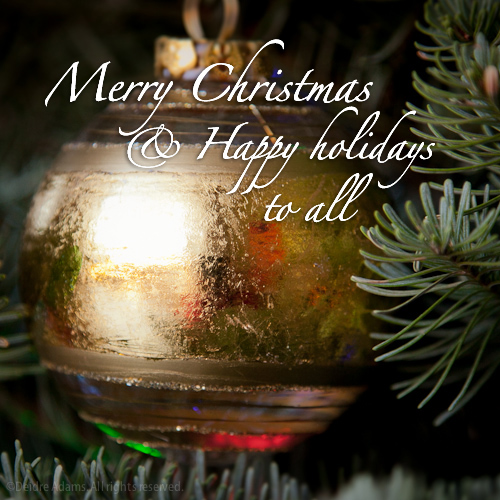
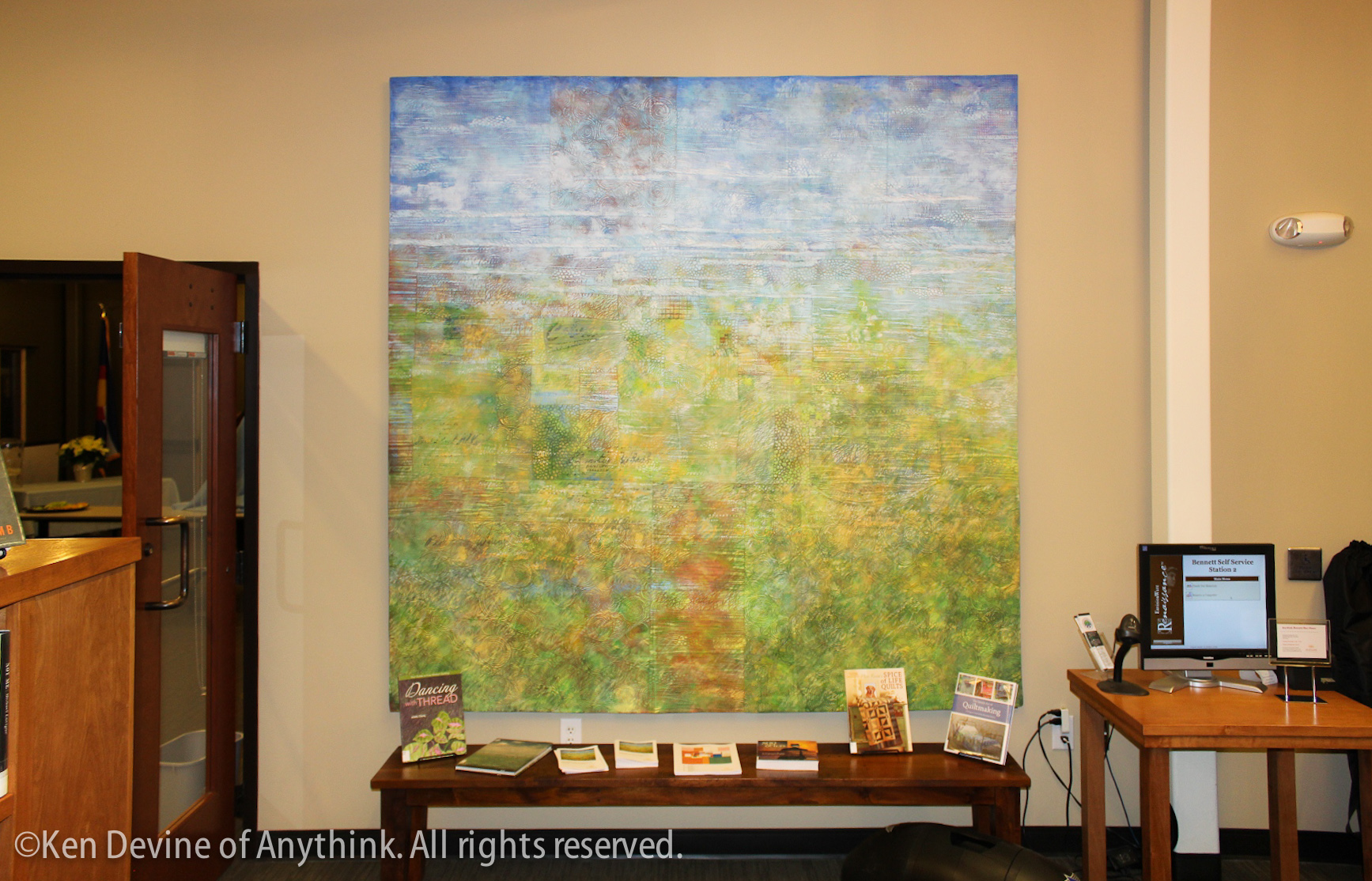 Horizon XVIII: Plainsong
Horizon XVIII: Plainsong
Hanging a textile piece can be done any number of ways. Some people like to frame them, but I’ve decided that that particular aesthetic doesn’t appeal to me. I believe a textile should be free to assert its own identity, and it shouldn’t be forced to pretend it’s a painting just because that’s what people are used to. The wrong kind of frame (too ornate, or calling too much attention to itself) can also, in my opinion, reduce a textile piece to functioning as mere decoration, looking like something you might find mass produced for display in a model home. Of alternative hanging methods, probably the most common involves stitching a sleeve to the back to accommodate a wooden or metal slat which can then be nailed to the wall. This allows the piece to hang free, and it’s what I usually do for my larger pieces.
However, this particular piece needed something more substantial. For another commission I did a couple of years ago, I had custom canvases built to size and stitched the pieces to them. This worked great for 36×36-inch pieces, but due to the sheer size of the current one, the ultimate problem of transportation ruled out that idea. So I enlisted the help of my very resourceful husband, and here’s what we came up with.
 This frame is built of light-weight but sturdy 1×2 (actual measurements .75 x 1.5 inches) hardwood. It was preprimed, so painting it black was very easy. The frame was built in two sections that bolt together, which meant we could fit it into our old Ford Explorer for transport. Library facilities men attached it to the wall.
This frame is built of light-weight but sturdy 1×2 (actual measurements .75 x 1.5 inches) hardwood. It was preprimed, so painting it black was very easy. The frame was built in two sections that bolt together, which meant we could fit it into our old Ford Explorer for transport. Library facilities men attached it to the wall.
 To attach the quilt to the frame, I used hook & loop tape from Uline. It comes with or without a sticky back. I bought sticky hook side, which I stuck to the entire perimeter of the frame, and some strategic spots on the inner supports. I didn’t think the stickiness alone would be enough, so I reinforced it with staples about every 5-6 inches. I bought the non-sticky loop side to attach to the quilt by hand stitching. I had said in a previous post that I’d found one aspect of making art that I really don’t like – this is it. Nope – no fun at all. When I am rich and famous, I shall hire someone to do this for me.
To attach the quilt to the frame, I used hook & loop tape from Uline. It comes with or without a sticky back. I bought sticky hook side, which I stuck to the entire perimeter of the frame, and some strategic spots on the inner supports. I didn’t think the stickiness alone would be enough, so I reinforced it with staples about every 5-6 inches. I bought the non-sticky loop side to attach to the quilt by hand stitching. I had said in a previous post that I’d found one aspect of making art that I really don’t like – this is it. Nope – no fun at all. When I am rich and famous, I shall hire someone to do this for me.
Because the hook & loop tape works quite well to attach the quilt to the frame, it also tries to stick itself anywhere it gets a chance, even if that’s in a spot you hadn’t intended. So it took all four of us to do the final hanging – two getting it into position, and two holding out the bottom so it couldn’t stick in the wrong spots prematurely.
 Lots of adjusting was then required to be sure it was in the exact right position to the frame.
Lots of adjusting was then required to be sure it was in the exact right position to the frame.
 Later that afternoon, the library held a small reception for all the people who had participated in the project.
Later that afternoon, the library held a small reception for all the people who had participated in the project.
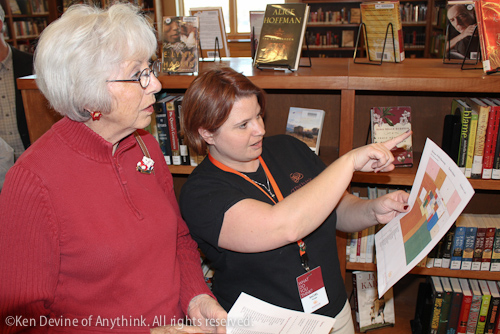 Since the painting over the fabric made it difficult to see, I had also made a map showing where in the piece each person’s fabric was used.
Since the painting over the fabric made it difficult to see, I had also made a map showing where in the piece each person’s fabric was used.
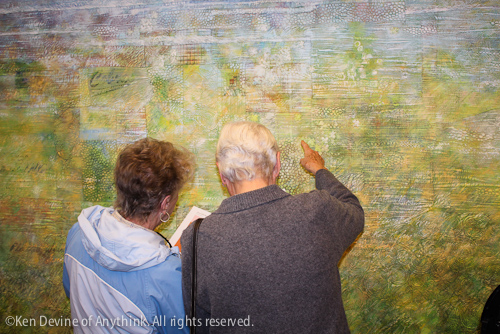 People seemed to be having a great time picking out their fabrics and telling one another about the meaning each piece had for them.
People seemed to be having a great time picking out their fabrics and telling one another about the meaning each piece had for them.
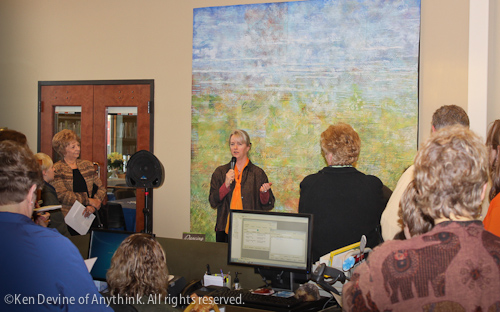 I had to say some “official words.”
I had to say some “official words.”
Then there was an afternoon tea with delightful refreshments, and a chance to talk to some of my new friends once again. The high point of the day was when a young girl asked me for my autograph and had her friend take a picture of us together. I felt like a rock star!
The last step of the painting process is to add small details, fine lines, and handwritten text to provide another layer of visual interest as well as give me a way to incorporate the words of the community members into the work. The writing consists partly of words from notes I took during the interview process. Names of animals, thoughts about the community, friends, schools, daily chores and activities – these are layered into a network of text which isn’t specifically meant to be read, but rather serves to “weave” these experiences into the texture of the work.
One of the interviewees, Charlotte Kerksiek, was a farmer’s daughter who spoke of her experiences growing up on a farm. Her father had come from Germany to live with an uncle in Iowa when he was 15 years old, and later started his own farm with his wife. Charlotte spoke very fondly of her parents, who were “country folk” and “so in touch with the land.” She remembers the lessons they taught: “to work hard, be honest, and pay our bills.” She brought written notes describing her memories:
I can see Dad walking through a cornfield, changing the irrigation water, leaning on a hoe in the garden to view the sunset, then pausing to point out a ‘Sweet William’ flower to me. His name was William. I can see mother hanging out the wash, separating the cream, gathering the eggs, walking down to the barn, hoeing in her garden, baking a cake for the afternoon club meeting, curling my sister’s hair.
On a farm you see and feel life around you and you learn to respect it. You know the real origins of milk, eggs and bread, that they don’t just spring up from the super market.
She also gave me some photocopies of pages from her father’s daily journal and some pages from his financial ledger, with a meticulous listing of receipts and expenses – for groceries, gas, hens, equipment, loan payments, payments to laborers, and various & sundry – including $1 for 2 lbs. Rat Poison, $6.60 to a furniture store for a baby bed, and $1 to a doctor for a baby checkup.
I also have photocopies of two letters he wrote, which allowed me a fascinating window into one man’s experiences as he built a life for himself. From a letter written from Kansas in 1935 (before he started his own farm):
Dear Friend:
Another year has run its course, we are again a year older, but have not much to show in financial gain, only a little knowledge added to our store of thought, but I am ready to admit that I have not gained much, even there. Am afraid that I do too much reading of rubbish and not enough of the kind that would improve one’s mind.
I am sure at last that farming will be my Life’s Work, although other things may be added, they will only be side lines. Farming will be the Main Feature, and it will be absolutely diversified. Cattle, Hogs, Chickens will the the main stay until I get a stronger hold, then Horses and Sheep may be added. Grains of different sorts and Silos when possible.
I scanned some of the text from the journal pages and made Thermofax screens for printing onto the painted piece. Because of the very rough surface, though, this didn’t work as well as I had hoped, so I switched to writing directly onto the piece itself, copying words from the journals and from my notes. I use a small squeeze bottle with a metal tip to do tiny details and writing.